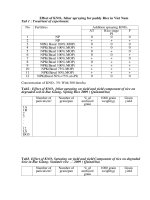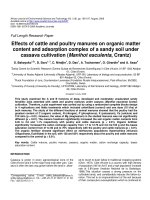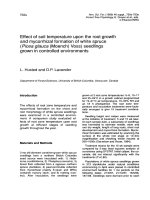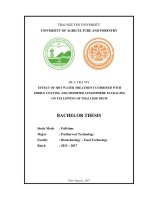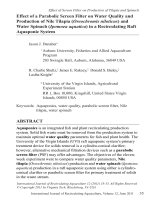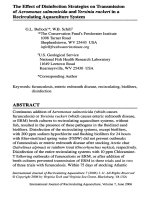Effect of sludge addition on biological properties of soil under rice cultivation
Bạn đang xem bản rút gọn của tài liệu. Xem và tải ngay bản đầy đủ của tài liệu tại đây (178.49 KB, 7 trang )
Int.J.Curr.Microbiol.App.Sci (2017) 6(5): 2677-2683
International Journal of Current Microbiology and Applied Sciences
ISSN: 2319-7706 Volume 6 Number 5 (2017) pp. 2677-2683
Journal homepage:
Original Research Article
/>
Effect of Sludge Addition on Biological Properties of
Soil under Rice Cultivation
Anil Kumar Verma1*, Raj Dev Singh1, Brijesh Yadav2,
Ravi Kumar Meena1 and Chiranjeev Kumawat1
1
Division of Soil Science and Agricultural Chemistry, 2Division of Agricultural Physics, ICARIndian Agricultural Research Institute, New Delhi 110012, India
*Corresponding author
ABSTRACT
Keywords
Alkaline soil,
biological
properties,
Sludge,
Rice
Article Info
Accepted:
25 April 2017
Available Online:
10 May 2017
A pot experiment was conducted to study the effect of sludge application
on metal uptake and biological properties of soil by basmati rice (Oryza
sativa, var Pusa Basmati 1121) grown on alkaline soil of IARI farm. In this
study, the sludge was collected from Okhla sewage treatment plant, South
Delhi. Sludge was added @ 0, 40, 80, 120, 160, and 200 g per pot of soil,
which are equivalent to field application of 0, 20, 40, 60, 80, and 100 t ha-1.
All six treatments were replicated thrice and experiments were laid out in
completely randomised design. The result shows that all the biological
properties viz. acid phosphatase, alkaline phosphatase and fluorescein
diacetate activity (FDA) were increased for all sludge treated pots over
control. Therefore, results can be concluded as sludge is a good source of
plant nutrients, nitrogen (N), phosphorus (P), potassium (K), sulphur (S)
and two important micronutrients i.e. of zinc (Zn) and iron (Fe) and also
helps in improvement in fertility and important biological properties of soil.
Introduction
Sewage sludge is a liquid-solid residue
resulting from the treatment of urban or
industrial effluents. The application of sewage
sludge in agriculture as a source of plant
nutrients and as soil conditioner is
increasingly being favoured by the farmers
not only in our country but across the globe.
The total sewage generated from urban areas
was estimated 62,000 million litres per day
(MLD) while the treatment capacity across
India is only 23,277 MLD, or 37% of sewage
generated (CPCB, 2016). Although sewage
sludge having a relatively variable
composition, it is rich in organic matter,
nitrogen (N), phosphorus (P)and sulphur (S)
potassium (K), calcium (Ca) and magnesium
(Mg)(Gray, 2010; Mtshali et al.,2014; Golui
et al., 2014). It can be considered as a viable
alternative for fertilizer, beside it act as a soil
conditioner. The properties and composition
of sewage sludge may vary with the sources
and season. Metal concentrations in sewage
sludge vary widely depends mainly on its
origin, for example, industrial wastes usually
2677
Int.J.Curr.Microbiol.App.Sci (2017) 6(5): 2677-2683
contain higher levels of heavy metals than
domestic wastes. Metal contents in sludge
also depend on the types of sewage treatment
process. Organic matter–metal associations
also differ between aerobically and
anaerobically digested sludge (Doelsch et al.,
2006). Characterization of the sewage sludge
as a source of plant nutrients becomes very
important due to the heterogeneity and
variability in the composition to predict its
fitness for use in agriculture. Addition of
sludge to agricultural soil is associated with
recycling of important major plant nutrients
such as N, P, K and S (Nandhakumar et al.,
1998; Martinez et al., 2002). More
importantly, these waste materials add
substantial amount of organic matter, besides
improving physical properties of soil like bulk
density, porosity, water holding capacity,
hydraulic conductivity and aggregate stability
(Singh and Agrawal, 2008). Cation exchange
capacity (CEC) of soil has been reported to
improve by addition of sewage sludge
(Ghahdarijani et al., 2015). Further,
application of sludge is capable of changing
soil pH, hence can be used in reclamation of
acid and sodic soil (Tsalidas et al., 1995).
Significant enhancement in microbial biomass
carbon, dehydrogenase activity and aggregate
associated organic matter has been reported
particularly when higher amount of sludge
was applied (Mondal et al., 2015).
Rice is one of the major staple food crops in
India. Currently, 43 million ha of land is
under the cultivation of this crop in our
country with the total production of 104
million tonnes (Commodity profile for rice
April, 2016). As such, there is very little
information related to impact of sludge
application on changes in soil biological
properties under rice crop (Singh and
Agrawal, 2010b; Latare et al., 2014). It can be
expected that impact of sludge application,
particularly
under
transplanted
rice
(submerged condition) will be quite different
than under other aerobically grown crops.
Keeping this in view, present study was
undertaken to assess the impact of sludge
addition on important soil biological
properties under rice cultivation.
Materials and Methods
Location and collection of soil and sludge
samples
To achieve the objectives of the present
investigation surface (0-15 cm) soil samples
were collected from experimental farm of
IARI (28˚30´ N, 77˚10´ E; 250 m amsl), New
Delhi. Soil of IARI farm belongs to Typic
Haplustept in sub-tropical semi-arid agroclimatic zone (precipitation 650 mm) of
Upper Gangetic Plain and sludge sample was
collected from sewage treatment plants of
Delhi viz. Okhla in the month of March,
2015. The treatment capacity of Okhla is 170
million gallon per day (MGD).
Characterization of soil and sludge
Soil samples were air dried ground and sieved
with a 2-mm nylon sieve. Soil samples were
dried, ground, and passed through 2-mm
sieve. Soil pH and electrical conductivity
(EC) was measured in the suspension
(soil/water, 2:1) according to Datta et al.,
(1997). Soil texture was determined by the
hydrometer method (Bouyoucos, 1962).
Organic carbon content in soil was
determined by the wet digestion method
(Walkley and Black, 1934). Available
nitrogen in soil was determined by alkaline
potassium permanganate (KMnO4) (Subbiah
and Asija, 1956). For available P, and K, soil
was extracted with 0.5 M NaHOC3 (Olsen et
al., 1954), and 1 M NH4OAC (Jackson,
1973). For heavy metal analysis, the soil
samples were extracted with0.005 M DTPA
(Lindsay and Norvell, 1978) and metals in the
extract were determined by ICP-MS. Arsenic
2678
Int.J.Curr.Microbiol.App.Sci (2017) 6(5): 2677-2683
was determined by extracting the soil sample
with 0.5 M NaHCO3pH 8.5 (Olsen et al.,
1954) and content of As in the extract was
measured by ICP-MS. Sludge samples were
air-dried, ground and sieved to pass through 2
mm sieve. The processed and homogenized
sludge was chemically analysed. Sludge
collected from Okhla was used in pot
experiment in since high amount of sludge is
generated from Okhla among these treatment
plants. Sludge samples were analysed for pH
(sludge/water, 1:5) and electrical conductivity
following standard procedures (Jackson,
1973). Organic carbon, total nitrogen and
sulphur were determined by dry combustion
method (Nelson and Sommers, 1982) in
CHNS analyser (Euro Vector make, Euro
EA3000 model).Sludge samples were dried at
60 °C in hot air oven, ground, and digested in
HNO3 (Merck KGaA, 64271 Darmstadt
Germany) using microwave (Multiwave ECO,
Anton Paar). Total Zn, Cu, Fe, Mn, Ni, Cd,
Pb and As in digest was determined with ICPMS (PerkinElmer Nex-ION 300).Phosphorus
and potassium content in the digest was
determined following ascorbic acid method
(Watanabe and Olsen, 1965) using
spectrometer
and
flame
photometer,
respectively.
Initial
characteristics
of
experimental soils and sludge were given in
Table 1.
Pot experiment
A pot experiment was conducted to study the
effect of sludge application on metal uptake
by basmati rice (Oryza sativa, var Pusa
Basmati 1121) grown on alkaline soils. Plastic
pots of 5 kg capacity were filled with 4 kg of
IARI soil. A uniform dose of N: P2O5: K2O @
75: 40: 30 mg kg-1 soils were added in
solution form to the soil of each pot through
urea, potassium dihydrogen phosphate and
muriate of potash. Half of N and full dose of
P and K were applied at the time of
transplanting of rice and remaining N
fertilizer was applied in two equal splits at
tillering and flower initiation stage. The
sludge collected from Okhla was added @ 0,
40, 80, 120, 160, and 200 g per pot of soil,
which are equivalent to field application of 0,
20, 40, 60, 80, and 100 t ha-1. All six
treatments were replicated thrice and
experiments were laid out in completely
randomised design. The soil in each pot was
irrigated with tap water and the pots were
maintained the submerged condition during
whole crop growth period. Simultaneously, a
tray (45 x 30 x 15 cm3) was filled with
processed IARI soil. Soil was irrigated with
tap water to maintain moisture content at field
capacity and kept overnight. About 10g of
rice seeds (Oryza sativa, var. Pusa Basmati
1121) were sown. Then about 5 rice seedlings
(15 days old) were transplanted in each pot.
Required intercultural operations were carried
out according to necessity. Plants were
harvested at maturity. After harvesting, fresh
soils were used for subsequent biological
properties analysis. Acid phosphatase activity
and alkaline phosphatase enzymes were
estimated colorimetrically by method
suggested by Tabatabai and Bremner (1970).
Fluorescein
diacetate
hydrolysis
was
estimated as per the method outlined by
Green et al., (2006). We analyzed soil
properties using analysis of variance
(ANOVA) for a complete randomized design.
Tukey’s honestly significant difference test
was used as a post hoc mean separation test (P
< 0.05) using SAS 9.1 (SAS Institute, Cary,
North Carolina, USA). The Tukey’s
procedure was used where the ANOVA
performed significant.
Results and Discussion
Microbial activity is a good measure of
organic matter turnover in soil since generally
more than 90% of energy flow through
microbial decomposer (Heal and MacLean,
1975). Hence activity of acid phosphatase,
alkaline phosphatase and fluorescein diacetate
in soil was studied in sludge amended soil.
2679
Int.J.Curr.Microbiol.App.Sci (2017) 6(5): 2677-2683
The acid phosphatase content in soil increased
to the tune of 0.1, 0.7, 1.73, 2.18 and 2.56 µg
p-nitrophenol g-1 h-1over controls due to
addition of sludge of 10, 20, 30, 40 and 50 g
kg-1, respectively (Table 2). Activity of all the
enzymes
was
reported
to
enhance
significantly due to addition of sludge
(Asagiet al., 2007; Frac and Tys, 2011). Soil
enzymes are indicators of microbial activities
in soils which are often considered as an
indicator of soil health and fertility. Alkaline
phosphatase also increases over control as
0.87, 1.14, 1.91, 3.16 and 3.8 µg pnitrophenol g-1 h-1 due to sludge addition @ of
10, 20, 30, 40 and 50 g kg-1, respectively
(Table 2). Acid phosphatase catalyses
reaction at acidic pH leading to utilization of
organically bound P by microbes. In other
words phosphatase enzymes are used by
microorganism to excess organically bound P.
Table.1 Initial characteristic of experimental soil and sludge of April, 2015
Parameters
IARI soil
8.0
pH 1:2
EC1:2 (dS m-1)
Mechanical composition
Clay (%)
Silt (%)
Sand (%)
Texture
Organic carbon (g kg-1)
0.24
12.0
15.0
73.0
sandy loam
3.8
+
Cation exchange capacity (cmol (p )
kg-1)
Sludge
6.73
3.92
13.9*
16.9
Available N (mg kg-1)
94.6
1.67*
Available P (mg kg-1)
8.51
1.60 *
Available K (mg kg-1)
DTPA Extractable nutrients
139
0.18 *
Fe (mg kg-1)
4.11
0.95 *
Zn (mg kg-1)
2.06
1186 **
Cu (mg kg-1)
1.24
94.1 **
Mn (mg kg-1)
7.26
128 **
Ni (µg kg-1)
118
16.5 **
Cd (µg kg-1)
38.3
4.75 **
Pb (mg kg-1)
0.94
32.7 **
Olsen extractable As (µg kg-1)
9.51
2.37**
* Total nutrients (%) ** Total heavy metal (mg kg-1)
2680
Int.J.Curr.Microbiol.App.Sci (2017) 6(5): 2677-2683
Table.2 Effect of sludge application on biological properties of soil
Rates of sludge addition
(g kg -1)
0 (control)
10
20
30
40
50
Acid phosphatase
(µg p-nitrophenol g-1 h-1)
3.41b
3.51b
4.11b
5.14a
5.59a
5.97a
Alkaline phosphatase
(µg p-nitrophenol g-1 h-1)
4.35d
5.22c
5.49bc
6.26a
7.51a
8.16a
Fig.1 Change in fluorescein diacetate (µg g-1) due to sludge application
After harvest of rice over control
Alkaline phosphatase is hydrolyses enzyme
responsible for removing phosphate group
from organic compound (Tabatabi, 1982).
There was significant increase in Fluorescein
diactate content in soil after harvest of rice
when sludge was added at the rate of 10, 20,
30, 40 and 50 g kg-1corresponding increased
being 3.1, 3.5, 4.1, 4.4, 7.2µg g-1 over control
(Figure 1). Fluorescein diacetate has been
used to determine amount of active fungi and
bacteria in soil (Sodestrom, 1977; Lundgren,
1981). It is hydrolyse by a number of different
enzymes such as protease, lipases and
asterases. The product of this enzymatic
conversion is fluorescein, which can visualize
within cells by fluorescein microscopy.
Fluorescein can also be quantified by
flurometery or spectrophotometery (Schnurer
and Rosswall, 1982). Hence fluorescein
diacetate is an indicator of overall activity of
decomposer microorganism. In the present
study, higher activity of all these enzymes
was observed in sludge treated soil may be
attributed to readdition of organic matter
through sludge, which is turned increase in
the population of microbes and stimulated
enzymatic activity in soil.
In conclusion, results can be concluded as
sludge is a good source of plant nutrients,
nitrogen (N), phosphorus (P), potassium (K),
sulphur (S) and two important micronutrient
2681
Int.J.Curr.Microbiol.App.Sci (2017) 6(5): 2677-2683
contents i.e. of zinc (Zn) and iron (Fe) and
also helps in improvement in fertility and
important biological properties of soil.
References
Asagi, N., Ueno, H. and Ebid, A. 2007. Effects
of sewage sludge applicationon rice
growth, soil properties, and N fate in low
fertile paddy soil. Int. J. Soil Sci., 2: 171181.
Bouyoucos, G.J. 1962. Hydrometer method
improved for making particle size
analyses of
soils. Agronomy J., 54:
464-465.
Commodity profile for rice April. 2016.
Admin_Agricoop/
Uploaded
File/Rice_Apr15.pdf
CPCB. 2016. Performance evaluation of sewage
treatment plants under NRCD. Central
Pollution Control Board, Delhi, India.
Datta, S.P., Subba Rao, A. and Ganeshamurthy,
A.N. 1997. Effect of electrolytes coupled
with variable stirring on soil pH. Journal
of the Indian Society of Soil Science
45:185-187.
Doelsch, E., Van de Kerchove, V. and Saint
Macary, H. 2006. Heavy metal content in
soils
of Réunion (Indian Ocean).
Geoderma, 134: 119-134.
Frąc, M., and Jezierska-Tys, S. 2011.
Agricultural utilisation of dairy sewage
sludge: Its
effect on enzymatic
activity and microorganisms of the soil
environment. African J.
Microbiol.
Res., 5: 1755-1762.
Ghahdarijani, A.J., Kalbasi, M. and Ghehsareh,
A.M. 2015. Effect of application of
sewage sludge and two synthetic humic
acids on selected chemical properties of
three soils. Biol. Forum, 7: 344-348.
Golui, D., Datta, S.P., Rattan, R.K., Dwivedi,
B.S. and Meena, M.C. 2014. Predicting
bioavailability of metals from sludgeamended soils. Environ. Monitoring and
Assessment, 186: 8541-8553.
Gray, N.F. 2010. Water technology: an
introduction for environmental scientists
and
engineers (No. Ed. Mtshali 3).
IWA Publishing.
Green, V.S., Stott, D.E. and Diack, M. 2006.
Assay for fluorescein diacetate hydrolytic
activity: optimization for soil samples.
Soil Biol. Biochem., 38: 693-701.
Heal, O.W., and MacLean J.S.F. 1975.
Comparative productivity in ecosystemssecondary
productivity.
Unifying
Concepts in Ecol., (pp. 89-108).
Jackson, M.I.L. 1973. Soil Chemical Analysis.
Prentic Hall (India) Pvt. Ltd. New Delhi.
Latare, A.M., Kumar, O., Singh, S.K. and
Gupta, A. 2014. Direct and residual effect
of sewage sludge on yield, heavy metals
content and soil fertility under rice–wheat
system. Ecol. Engi., 69: 17-24.
Lindsay, W.L. and Norvell, W.A. 1978.
Development of a DTPA soil test for zinc,
iron,
manganese and copper. Soil Sci.
Society of America J., 42: 421-428.
Lundgren, B. 1981. Fluorescein diacetate as a
stain of metabolically active bacteria in
soil. Oikos, 36: 17-22.
Martinez, F., Cuevas, C., Teresa, Walter and
Iglesias Ingrid. 2002. Urban organic
wastes effects on soil chemical
properties
in
degraded
semiarid
ecosystem. In: Seventeenth
WCSS,
Symposium No. 20, Thailand. p.1-9.
Mondal, S., Singh, R.D., Patra, A.K. and
Dwivedi, B.S. 2015. Changes in soil
quality in
response to short-term
application of municipal sewage sludge in
a Typic Haplustept
under cowpeawheat cropping system. Environmental
Nanotechnology, Monitoring
and
Management, 4: 37-41.
Mtshali, J.S., Tiruneh, A.T. and Fadiran, A.O.
2014. Characterization of sewage sludge
generated from wastewater treatment
plants in Swaziland in relation to
agricultural uses. Res. Environ., 4: 190199.
Nandakumar, K., Ramamurthy, S., Rajarajan,
A. and Savarimuthu, E. 1998. Suitability
of Dindigul town’s sewage sludge for
field application: nutritional perspective.
Poll. Res., 17: 61-63.
2682
Int.J.Curr.Microbiol.App.Sci (2017) 6(5): 2677-2683
Nelson, D.W. and Sommers, L.E. 1982. Total
carbon, organic carbon, and organic
matter. Methods of soil analysis. Part
2.Chemical
and
microbiological
properties, (methodsofsoilan2), 539-579.
Olsen, S.R., Cole, C.V., Watanabe, F.S. and
Dean, L.A. 1954. Estimation of available
phosphorus in soils by extraction with
sodium bicarbonate. U. S. Department of
Agriculture Circular No. 939. Banderis,
A.D., D.H. Barter and K. Anderson,
Agricultural and Advisor.
Schnürer, J. and Rosswall, T. 1982. Fluorescein
diacetate hydrolysis as a measure of total
microbial activity in soil and litter. Appl.
Environ. Microbiol., 3: 1256-261.
Singh, R.P. and Agrawal, M. 2008. Potential
benefits and risks of land application of
sewage sludge. Waste Management, 28:
347-358.
Singh, R.P. and Agrawal, M. 2010b. Variations
in heavy metal accumulation, growthand
yield of rice plants grown at different
sewage
sludge
amendment
rates.
Ecotoxicol. Environ. Safety, 73: 632-641.
Söderström, B.E. 1977.Vital staining of fungi in
pure cultures and in soil with fluoresce in
diacetate. Soil Biol. Biochem., 9: 59-63.
Subbiah, B.V. and Asija, G.L. 1956. A rapid
procedure for the estimation of available
nitrogen in soils. Curr. Sci., 25: 259-260.
Tabatabai, M.A. 1982. Soil enzymes Methods
of Soil Analysis Part 2. Chem. Microbiol.
Properties, 2: 903-947.
Tabatabai, M.A. and Bremner, J.M. 1970.
Arylsulfatase activity of soils. Soil Sci.
Society of America J., 34: 225-229.
Tsadilas, C.D., Matsi, T., Barbayiannis, N. and
Dimoyiannis, D. 1995. Influence of
sewage sludge application on soil
properties and on the distribution and
availability of heavy
metal fractions.
Communications in Soil Sci. Plant
Analysis, 26: 2603-2619.
Walkley, A. and Black, I.A. 1934. An
examination of the degtjareff method for
determining
soil organic matter, and
a proposed modification of the chromic
acid titration method. Soil Sci., 37: 29-38.
How to cite this article:
Anil Kumar Verma, Raj Dev Singh, Brijesh Yadav, Ravi Kumar Meena and Chiranjeev Kumawat.
2017. Effect of Sludge Addition on Biological Properties of Soil under Rice Cultivation.
Int.J.Curr.Microbiol.App.Sci. 6(5): 2677-2683. doi: />
2683

